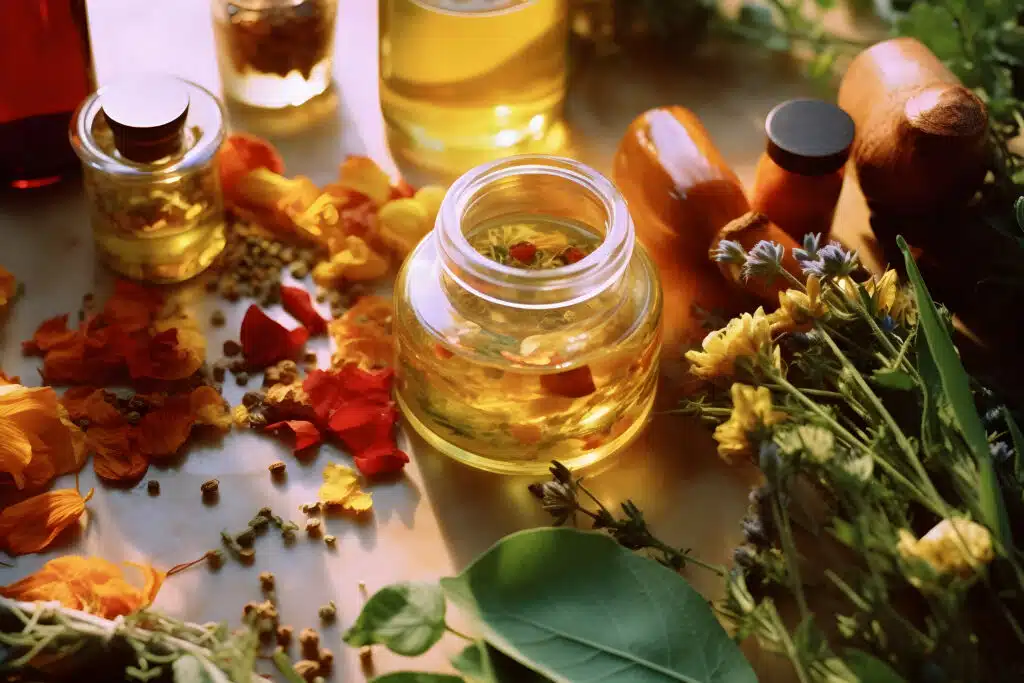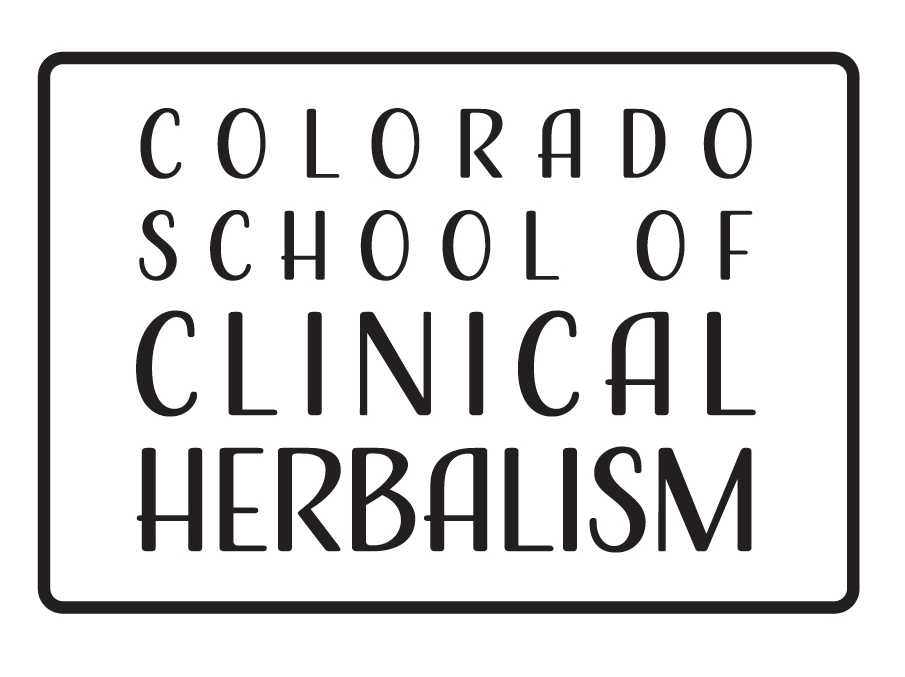
By Amy Leithliter
12 Herbal Oils for Topical Use
Infusing your own body oils is an easy, affordable, and luxurious way to engage in radical self-care while reducing the amount of toxic chemicals you put on your skin, which are hidden in staggering amounts in most personal care products. The skin is the largest organ of the body and topical application of herbs can be a great way to get them into your system and into your daily routine. You can use these infused oils individually or in blends to use for self-massage (or with a friend) or to add to the bath. They can be turned into salves with the addition of beeswax, shea butter, or cocoa butter, or into lotions with hydrosols.
You’ll find some of my favorite herbs to infuse into oil for topical use below, though most can be used in your kitchen depending on the oil you use for infusing; any exceptions will be noted.
Calendula
Calendula is a premier healer of the skin due to its anti-inflammatory and tissue regenerating properties, used for slow-healing injuries, bug bites, sprains, hemorrhoids, chronic skin issues and so much more. As a gentle lymph mover, it can be part of a routine to support the healthy movement of fluids in the body. It is considered one of the safest herbs to use during pregnancy, postpartum, and with babies.* Caution with those who have Asteraceae family sensitivities (like chamomile). Do not use it on open wounds as its wound-healing effect has the potential to seal in infection.
* use less herb to oil ratio when crafting oils that will be used with young children, or dilute your regular herbal oil with more carrier oil so the scent is light.
Chamomile
Chamomile oil is an ally for the nervous system, helping to soften both emotional and physical tension, making it a great massage oil for tense muscles, stressful times, period cramps, and insomnia. Due to its anti-inflammatory and skin-healing properties, it finds its way into blends focused on soothing red, itchy skin conditions, and wound healing in general. This is another herb that is considered generally safe for little ones.* Caution with those who have Asteraceae family sensitivities.
* use less herb to oil ratio when crafting oils that will be used with young children, or dilute your regular herbal oil with more carrier oil so the scent is light.
Comfrey
Comfrey oil is fantastic to have on hand for sprains, strains, broken bones and wounds that have closed and are healing nicely (i.e. no pus or signs of infection) and shouldn’t be used on puncture wounds as it is so effective that it speeds the upper layer of skin to heal faster than the layers below, possibly sealing in an infection. This is due to allantoin, a constituent that is a cell proliferant.
This is an oil that I’d recommend for externally use only due to its questionable pyrrolizidine alkaloid content and its cumulative action on the liver.
Conifers
You can use the needles or resin from pine, spruce, fir, or Douglas fir trees to create beautiful-smelling oils. Each will have its own scent profile and they often blend together beautifully. I find that Douglas fir oil has that Christmas tree smell, blue spruce is sweet like a candied forest (akin to walking the trails up at Brainard and Eldora areas – if you know, you know) and piñon pitch is heady yet grounding. Oils made with them help to increase circulation and warm the body, move crud in the lungs when used as a chest rub, are good for chapped skin, and are anti-inflammatory. The resins are antimicrobial and great for extending the shelf life of your oils.
Get to know the trees that are abundant in your area and develop a close relationship with them. Not all evergreen trees are conifers and some may be toxic, like yew trees. The book Wild Remedies has a great section on identifying different species of conifers and how to wildcraft from them in an ethical way that doesn’t damage the trees.
Ginger
Ginger is a warming herb that can help increase circulation. A great ally to use in blends for menstrual cramps or other reproductive complaints related to pelvic stagnation, as well as cold winter feet or to warm the body up when you have the chills at the beginning of a fever. Use the dried herb–a little goes a long way!
Lavender
Lavender-infused oil is one of my favorites–it smells divine! I find it preferable to the essential oil, having a more grounded and rounded-out scent. It is both uplifting and calming at the same time, making a great ally for irritability, agitation, and restless nights. Many use lavender in combination with rosemary for headaches. It is a medicine chest of an herb: tonifying to the nervous system, healing to wounds and burns*, and antibacterial. What can’t this beauty do?
* don’t use oils on fresh burns as doing so can seal in the heat – better to use a diluted infused vinegar or tea while the burn is acutely hot/inflamed and then use oil once the heat has dissipated.
Mugwort
Mugwort is warming and deeply penetrating, helping to relax tense muscles and assist other herbs to move deeper into the tissues. It can be used in blends for menstrual pain, bringing on delayed menses, general body aches + pains, and in warming winter blends. It is also considered a dreamtime herb, making it a potent ally for a pre-bedtime ritual.
Rose Petals
Rose is often used in facial care products to help tone the skin and reduce redness. But I think that it really shines as an ally for the spiritual heart, helping to soften and open the heart while establishing firm boundaries (soft petals meet thorn medicine). It is calming and uplifting to the nervous system, helping to ease anxiety and depression. Some have found rose oil to be useful in reducing low back pain during pregnancy.
For a stronger scent and color, it is best to infuse your oil 2-3 times with batches of petals, using a light oil like jojoba, sunflower oil, or apricot kernel oil.
Yarrow
Another herbal medicine chest, yarrow stimulates circulation while also reducing excess bleeding, reduces inflammation, warms and tones the tissue, relieves itchiness, and more. It is great in blends for menstrual pain, stagnant tissues, and injuries. It can be applied to adults and children alike when feverish and chilled to gently warm the body and open the pores.
Herbs Best Infused Fresh
Always be 100% sure of your identification of any plants you harvest, whether for topical use or internal; even plants that are closely related can have very different properties and cautions. Please embody the guidelines of ethical wildcrafting so the stands are tended with care for generations to come.
Arnica
Arnica is a well-known classic for sprains, strains and contusions. It is great to use when sore due to overexertion or immediately following an injury that you anticipate will bruise, helping to warm and increase circulation to the area of application. If heat brings relief to an injury, this is a great ally. Do not use on open cuts or wounds.
Arnica should only be used externally except for homeopathic products intended for internal use.
Cottonwood Buds
The scent of cottonwood oil is hard to describe, but the word intoxicating comes to mind. It reminds me of coming across a lush river in the deserts of Utah, in the best way possible. It might be my favorite oil that I make each year and I use it in almost all of my massage blends as it can help to relieve pain and inflammation. It’s also softening and nourishing to dry, cracked skin, warming, relieves itchiness and is antimicrobial which helps to extend the shelf life of your oils.
Cottonwood buds are harvested during the winter months through early spring, shortly before the leaves start unfurling. There is often a windfall of small branches below the trees after storms so there is no need to harvest buds directly off of the trees. Look for buds that are plump, have a pearl of resin on them, and are free from black spots.
St John’s Wort
This ruby red oil is one of my absolute favorites for nourishing the nervous system, both physically and emotionally, and I try to always have some on hand. It is similar to arnica, often being used for bruises, sprains, and other injuries. It really shines with healing nerve pain and nerve injury, making it great for the later stages of healing cesarean and other surgical incisions, helping to reduce pain and scarring. As an herb of high summer that captures the essence of the sun, it is a sweet, warming herb to add to your winter blends to lift the spirit and combat Seasonal Affective Disorder.
❤
To learn more about making your own potent herbal oils, join me for my Herbal Body Oil Playshop on December 4th, 2023 from 6-8pm.
Amy is a student in the clinical program at The Colorado School of Clinical Herbalism, as well as a licensed massage therapist, infant massage educator, and postpartum care provider.
Resources
Wild Remedies by Rosalee de la Forêt and Emily Han
The Herbal Kitchen by Kami McBride
Mountain State Medicinal Plants by Briana Wiles
Herbal Healing for Women by Rosemary Gladstar
Aphrodisiac by Kimberly Gallagher
https://www.ewg.org/personal-care-products-safety-act-would-improve-cosmetics-safety
